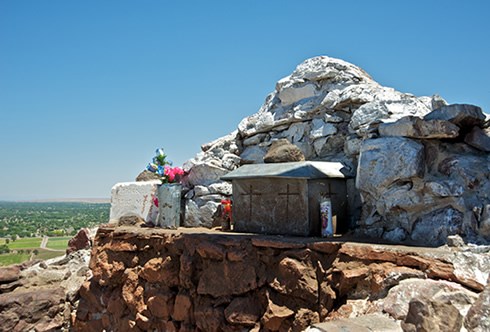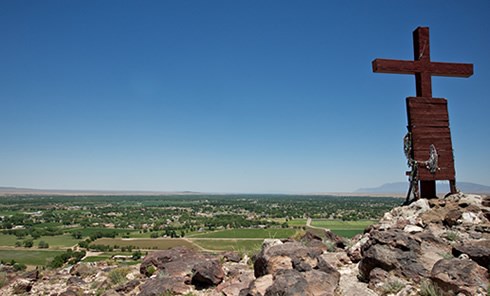Last updated: July 2, 2020
Article
New Mexico: El Cerro de Tomé
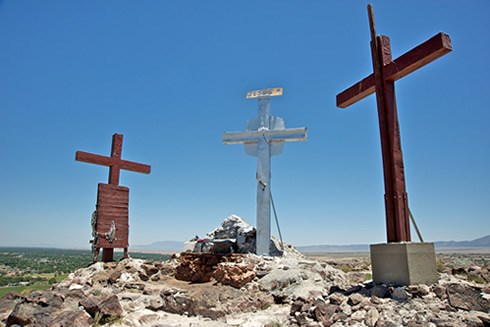
A lone hawk circles over El Cerro de Tomé (Tomé Hill) on a breezy, blue-sky morning. Its black basalt slopes rising 400 feet above the Rio Grande floodplain, 10 miles south of Isleta Pueblo, Tomé Hill marks a dramatic break in the flat landscape, drawing both the bird’s-eye view and the interest of visitors below. Their focal point is a cross-studded summit atop petroglyph-filled hillsides. All are modern-day reminders of Tomé Hill’s significance as a landmark on El Camino Real de Tierra Adentro and a place of multicultural spirituality from precontact times to today.
Religious pilgrims and recreational hikers access Tomé Hill from a small park where a large sculpture by Armando Alvarez, La Puerta del Sol, honors the history of El Camino Real travelers and frames a unique perspective of the climb ahead. Hiking the rocky trail to the summit, energetic visitors set their sights on the hilltop trio of crosses, where a masonry shrine holds rosaries, religious quotes and other articles of interest that testify to religious and secular faith. The site is owned and maintained by the local Town of Tomé Land Grant, which preserves its defining features to ensure visitors the experience of Tomé Hill’s stunning panoramic view—from fields and pasture lands to the north, west and south, to the eastern ridges of the Sandia and Manzano Mountain ranges, to the riverside bosque (woodland) and the grainy sand hills that border the floodplain.
An awesome remnant of New Mexico’s ancient volcanic past, Tomé Hill’s powerful sense of place has long made it a ceremonial site and place of pilgrimage for local Native and Hispano peoples. Petroglyphs spanning from 3000 BC through the 17th century connect the cultural practices of Native cultures to Tomé Hill through time in a tradition of ceremonial rock artistry expressing unique worldviews and cosmology. Isleta Pueblo residents considered Tomé Hill a landmark of their southern boundary and conducted ceremonies there until the early 20th century. Meanwhile, the 17th-century appearance of petroglyph images of crosses and other Christian symbols alongside Pueblo designs marks the arrival of Spanish colonists in the area and the emerging cross-cultural significance of Tomé Hill.
Tomé Hill’s adoption by Hispano residents links to the settlement of the village of Tomé, two miles to the southwest. In 1659, Spanish soldier Tomé Domínguez de Mendoza, whose parents and two siblings had traveled to the area along El Camino Real, and who served as New Mexico’s interim governor in 1664, received a royal land grant. He built a home near Tomé Hill, adjacent to the Rio Grande. Evidence suggests that the main route of El Camino Real, paralleling the river, passed along the butte’s western edge. In times of flooding, it is believed that El Camino Real arched around the eastern edge of the hill through the sand hills.
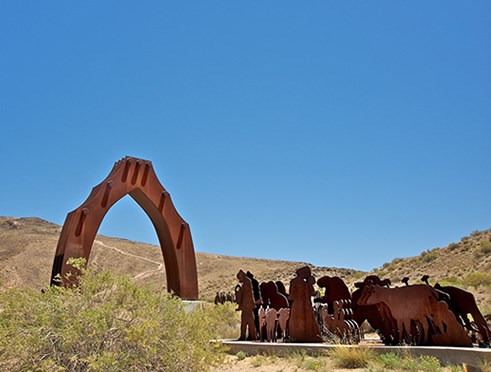
Domínguez de Mendoza fled his home during the 1680 Pueblo Revolt for El Paso del Norte. Rather than returning to New Mexico with the 1692 resettlement, he went to Spain instead. Nonetheless, when the Tomé Land Grant was conveyed in 1739, his name stuck as an agricultural community of genízaros, or detribalized Christianized Indians, and Indian-Spanish mestizos took shape on the isolated southern frontier of the Spanish province. By then, the Rio Grande had changed course, and a new route of El Camino Real had formed to the west, running through the valley and by the new village plaza.
From Comanche raiders in the late 18th century to Confederate soldiers in retreat from the Glorieta battlefield in 1862, Tomé Hill drew the attention of passersby on El Camino Real as New Mexico evolved from Spanish province to Mexican republic to U.S. Territory. Many 19th-century adventurers noted the religious activities of townspeople. Lieutenant W.H. Emory, who visited Tomé while assessing for the U.S. War Department whether possession of the Southwest warranted a war with Mexico, wrote, “We marched and encamped near Tomé. It was the eve of the fete of Tomé in honor of the Virgin Mary, and people from all parts of the country were flocking in crowds to the town. . .At night there was a theatrical representation in the public square. The piece dramatized was from the Old Testament.”
By the mid-19th century, the Hermanos Penitentes (Penitent Brotherhood), a lay Catholic fraternity that assisted with religious rituals in some communities lacking parish priests, had a strong and influential presence in Tomé, where a priest and a village church, Our Lady of the Conception, were also firmly established. In the early 1830s, trader, explorer and author Josiah Gregg witnessed a Good Friday penitente reenactment of Christ carrying the cross in the village plaza. By the early 20th century, the penitentes had established a new Good Friday tradition, summiting Tomé Hill for the reenactment of Christ’s passion, and erecting a cross up top.
The ceremonial practices of the penitentes and area residents on Tomé Hill waned by the end of World War II, but a revival of interest in the 1950s ultimately restored its spiritual role and vital sense of place in the community. When community member and Tomé Hill custodian Edwin Berry spearheaded the permanent placement of the crosses and shrine at the summit, improved trails and revived the Good Friday procession, new generations of pilgrims ventured to the site.
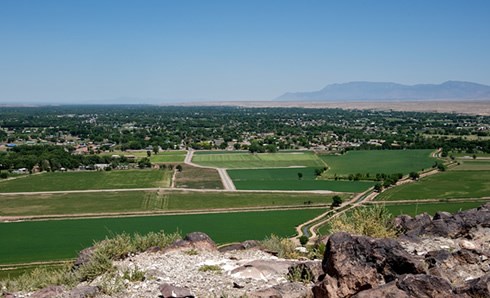
Today, Tomé Hill hosts one of New Mexico’s most vibrant Good Friday pilgrimage traditions, drawing countless hundreds of pilgrims who overflow area roadways as they walk from as far as Albuquerque to the site. The hill is also a year-round destination for those seeking recreation who are drawn to its natural beauty for a short day hike or hilltop meditation. Whatever their reasons for coming, all choose a pathway up Tomé Hill that leads a personal sacred or secular mission to the top.
El Cerro de Tomé is located in Valencia County, about 25 miles south of Albuquerque and five miles southeast of Los Lunas, approximately one-half mile east of the junction of NM 47 and Tomé Hill Rd. in Valencia County, NM. El Cerro de Tomé is listed in the National Register of Historic Places.
Driving Directions: Take Interstate 25 throughout Albuquerque to Avenida Cesár Chávez exit and turn left on Broadway, also known as NM 47, which follows the course of the El Camino Real many miles south. Follow NM 47 south through Isleta Pueblo, Bosque Farms, Peralta and Valencia. Just past Valencia, turn left at North El Cerro, also known as NM 263. Follow North El Cerro to Sand Hill Rd. and turn right. Follow Sand Hill Rd. until the point at which the Cerro is on the left and a parking area and small park at right. The park features interpretive wayside exhibits describing the history of the Tomé Hill landmark and its association with El Camino Real. To visit the village of Tomé, two miles southwest of Tomé Hill, turn left out of the Tomé Hill parking lot and follow to Romero Road. Turn right on Romero Road and drive back to NM 47.
The site is open to the public year round with limited wheelchair access in Tomé Hill Park.
Explore more history by visiting the El Camino Real travel itinerary website.
